Treasury and Risk Management: Swiss National Bank and Currency Risk
VerifiedAdded on 2021/04/24
|8
|1692
|20
Report
AI Summary
This report provides an in-depth analysis of treasury and risk management, focusing on the Swiss National Bank's decision to de-peg the Swiss franc from the Euro. It explores the reasons behind this decision, including the weakening of the Euro, the perceived safety of the Swiss franc, and the bank's concerns about the impact on the Swiss economy. The report then delves into various hedging strategies, such as invoicing, pricing policy, matching, netting, and leading and lagging, explaining how these strategies can help companies mitigate currency risk. Furthermore, the report examines different risk management approaches, including unhedged, forward hedge, money market hedge, and option hedge strategies, providing examples and discussing the advantages and disadvantages of each. The money market hedge strategy is highlighted as a favorable option for a company like ABC Company. The report concludes by emphasizing the importance of implementing proper exchange rate hedging mechanisms to avoid major financial losses resulting from currency volatility. The report also includes a detailed list of references.
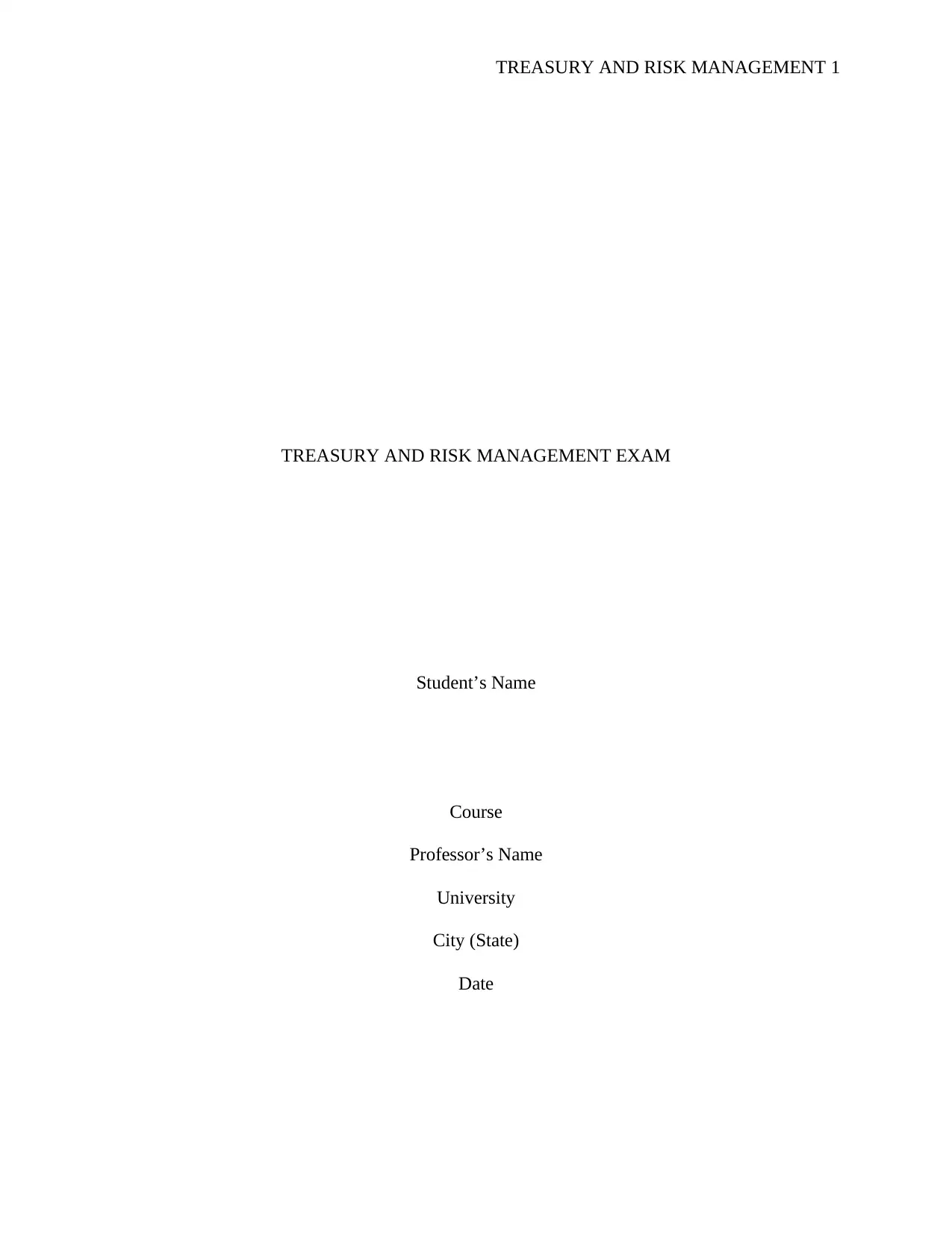
TREASURY AND RISK MANAGEMENT 1
TREASURY AND RISK MANAGEMENT EXAM
Student’s Name
Course
Professor’s Name
University
City (State)
Date
TREASURY AND RISK MANAGEMENT EXAM
Student’s Name
Course
Professor’s Name
University
City (State)
Date
Paraphrase This Document
Need a fresh take? Get an instant paraphrase of this document with our AI Paraphraser
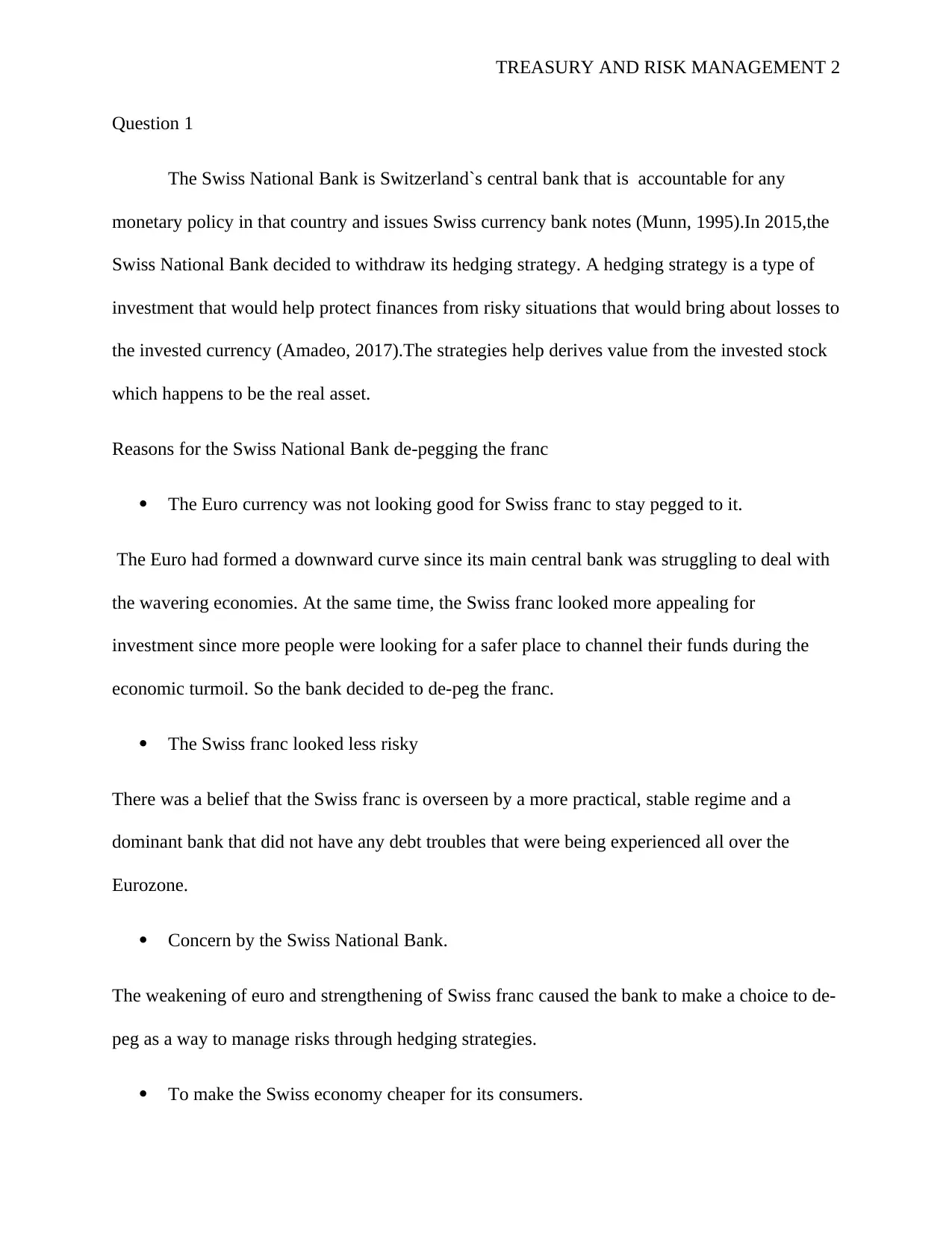
TREASURY AND RISK MANAGEMENT 2
Question 1
The Swiss National Bank is Switzerland`s central bank that is accountable for any
monetary policy in that country and issues Swiss currency bank notes (Munn, 1995).In 2015,the
Swiss National Bank decided to withdraw its hedging strategy. A hedging strategy is a type of
investment that would help protect finances from risky situations that would bring about losses to
the invested currency (Amadeo, 2017).The strategies help derives value from the invested stock
which happens to be the real asset.
Reasons for the Swiss National Bank de-pegging the franc
The Euro currency was not looking good for Swiss franc to stay pegged to it.
The Euro had formed a downward curve since its main central bank was struggling to deal with
the wavering economies. At the same time, the Swiss franc looked more appealing for
investment since more people were looking for a safer place to channel their funds during the
economic turmoil. So the bank decided to de-peg the franc.
The Swiss franc looked less risky
There was a belief that the Swiss franc is overseen by a more practical, stable regime and a
dominant bank that did not have any debt troubles that were being experienced all over the
Eurozone.
Concern by the Swiss National Bank.
The weakening of euro and strengthening of Swiss franc caused the bank to make a choice to de-
peg as a way to manage risks through hedging strategies.
To make the Swiss economy cheaper for its consumers.
Question 1
The Swiss National Bank is Switzerland`s central bank that is accountable for any
monetary policy in that country and issues Swiss currency bank notes (Munn, 1995).In 2015,the
Swiss National Bank decided to withdraw its hedging strategy. A hedging strategy is a type of
investment that would help protect finances from risky situations that would bring about losses to
the invested currency (Amadeo, 2017).The strategies help derives value from the invested stock
which happens to be the real asset.
Reasons for the Swiss National Bank de-pegging the franc
The Euro currency was not looking good for Swiss franc to stay pegged to it.
The Euro had formed a downward curve since its main central bank was struggling to deal with
the wavering economies. At the same time, the Swiss franc looked more appealing for
investment since more people were looking for a safer place to channel their funds during the
economic turmoil. So the bank decided to de-peg the franc.
The Swiss franc looked less risky
There was a belief that the Swiss franc is overseen by a more practical, stable regime and a
dominant bank that did not have any debt troubles that were being experienced all over the
Eurozone.
Concern by the Swiss National Bank.
The weakening of euro and strengthening of Swiss franc caused the bank to make a choice to de-
peg as a way to manage risks through hedging strategies.
To make the Swiss economy cheaper for its consumers.
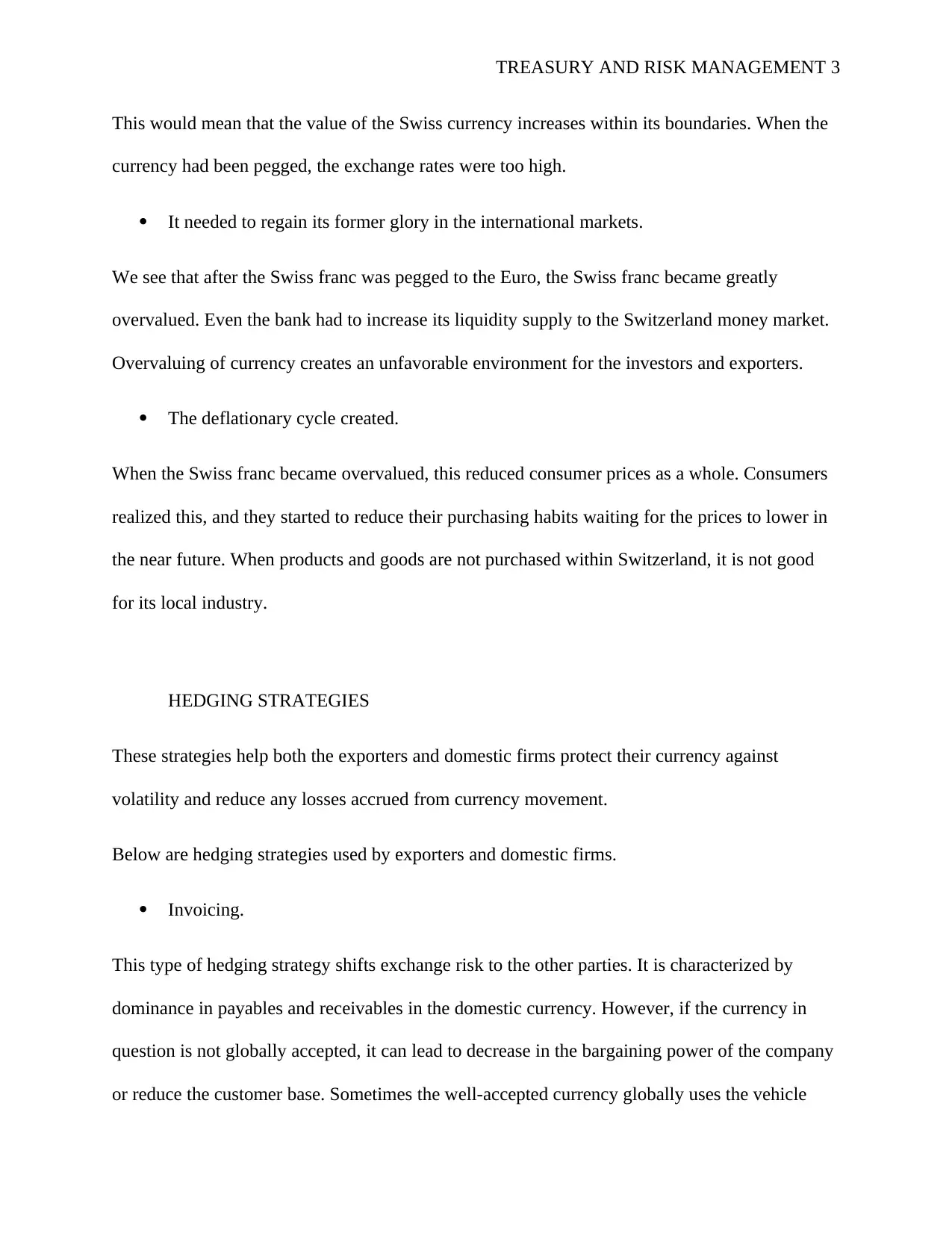
TREASURY AND RISK MANAGEMENT 3
This would mean that the value of the Swiss currency increases within its boundaries. When the
currency had been pegged, the exchange rates were too high.
It needed to regain its former glory in the international markets.
We see that after the Swiss franc was pegged to the Euro, the Swiss franc became greatly
overvalued. Even the bank had to increase its liquidity supply to the Switzerland money market.
Overvaluing of currency creates an unfavorable environment for the investors and exporters.
The deflationary cycle created.
When the Swiss franc became overvalued, this reduced consumer prices as a whole. Consumers
realized this, and they started to reduce their purchasing habits waiting for the prices to lower in
the near future. When products and goods are not purchased within Switzerland, it is not good
for its local industry.
HEDGING STRATEGIES
These strategies help both the exporters and domestic firms protect their currency against
volatility and reduce any losses accrued from currency movement.
Below are hedging strategies used by exporters and domestic firms.
Invoicing.
This type of hedging strategy shifts exchange risk to the other parties. It is characterized by
dominance in payables and receivables in the domestic currency. However, if the currency in
question is not globally accepted, it can lead to decrease in the bargaining power of the company
or reduce the customer base. Sometimes the well-accepted currency globally uses the vehicle
This would mean that the value of the Swiss currency increases within its boundaries. When the
currency had been pegged, the exchange rates were too high.
It needed to regain its former glory in the international markets.
We see that after the Swiss franc was pegged to the Euro, the Swiss franc became greatly
overvalued. Even the bank had to increase its liquidity supply to the Switzerland money market.
Overvaluing of currency creates an unfavorable environment for the investors and exporters.
The deflationary cycle created.
When the Swiss franc became overvalued, this reduced consumer prices as a whole. Consumers
realized this, and they started to reduce their purchasing habits waiting for the prices to lower in
the near future. When products and goods are not purchased within Switzerland, it is not good
for its local industry.
HEDGING STRATEGIES
These strategies help both the exporters and domestic firms protect their currency against
volatility and reduce any losses accrued from currency movement.
Below are hedging strategies used by exporters and domestic firms.
Invoicing.
This type of hedging strategy shifts exchange risk to the other parties. It is characterized by
dominance in payables and receivables in the domestic currency. However, if the currency in
question is not globally accepted, it can lead to decrease in the bargaining power of the company
or reduce the customer base. Sometimes the well-accepted currency globally uses the vehicle
⊘ This is a preview!⊘
Do you want full access?
Subscribe today to unlock all pages.

Trusted by 1+ million students worldwide
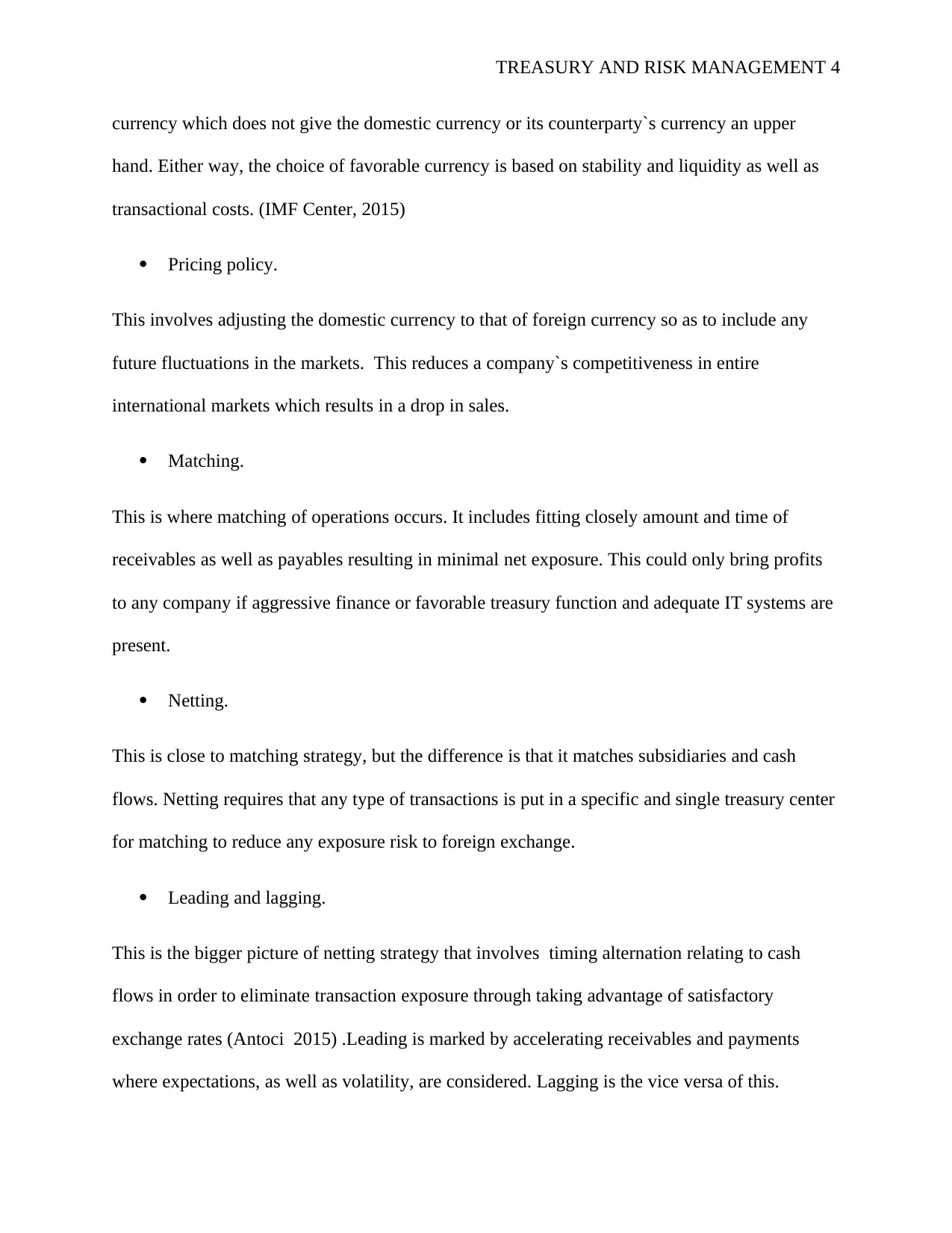
TREASURY AND RISK MANAGEMENT 4
currency which does not give the domestic currency or its counterparty`s currency an upper
hand. Either way, the choice of favorable currency is based on stability and liquidity as well as
transactional costs. (IMF Center, 2015)
Pricing policy.
This involves adjusting the domestic currency to that of foreign currency so as to include any
future fluctuations in the markets. This reduces a company`s competitiveness in entire
international markets which results in a drop in sales.
Matching.
This is where matching of operations occurs. It includes fitting closely amount and time of
receivables as well as payables resulting in minimal net exposure. This could only bring profits
to any company if aggressive finance or favorable treasury function and adequate IT systems are
present.
Netting.
This is close to matching strategy, but the difference is that it matches subsidiaries and cash
flows. Netting requires that any type of transactions is put in a specific and single treasury center
for matching to reduce any exposure risk to foreign exchange.
Leading and lagging.
This is the bigger picture of netting strategy that involves timing alternation relating to cash
flows in order to eliminate transaction exposure through taking advantage of satisfactory
exchange rates (Antoci 2015) .Leading is marked by accelerating receivables and payments
where expectations, as well as volatility, are considered. Lagging is the vice versa of this.
currency which does not give the domestic currency or its counterparty`s currency an upper
hand. Either way, the choice of favorable currency is based on stability and liquidity as well as
transactional costs. (IMF Center, 2015)
Pricing policy.
This involves adjusting the domestic currency to that of foreign currency so as to include any
future fluctuations in the markets. This reduces a company`s competitiveness in entire
international markets which results in a drop in sales.
Matching.
This is where matching of operations occurs. It includes fitting closely amount and time of
receivables as well as payables resulting in minimal net exposure. This could only bring profits
to any company if aggressive finance or favorable treasury function and adequate IT systems are
present.
Netting.
This is close to matching strategy, but the difference is that it matches subsidiaries and cash
flows. Netting requires that any type of transactions is put in a specific and single treasury center
for matching to reduce any exposure risk to foreign exchange.
Leading and lagging.
This is the bigger picture of netting strategy that involves timing alternation relating to cash
flows in order to eliminate transaction exposure through taking advantage of satisfactory
exchange rates (Antoci 2015) .Leading is marked by accelerating receivables and payments
where expectations, as well as volatility, are considered. Lagging is the vice versa of this.
Paraphrase This Document
Need a fresh take? Get an instant paraphrase of this document with our AI Paraphraser
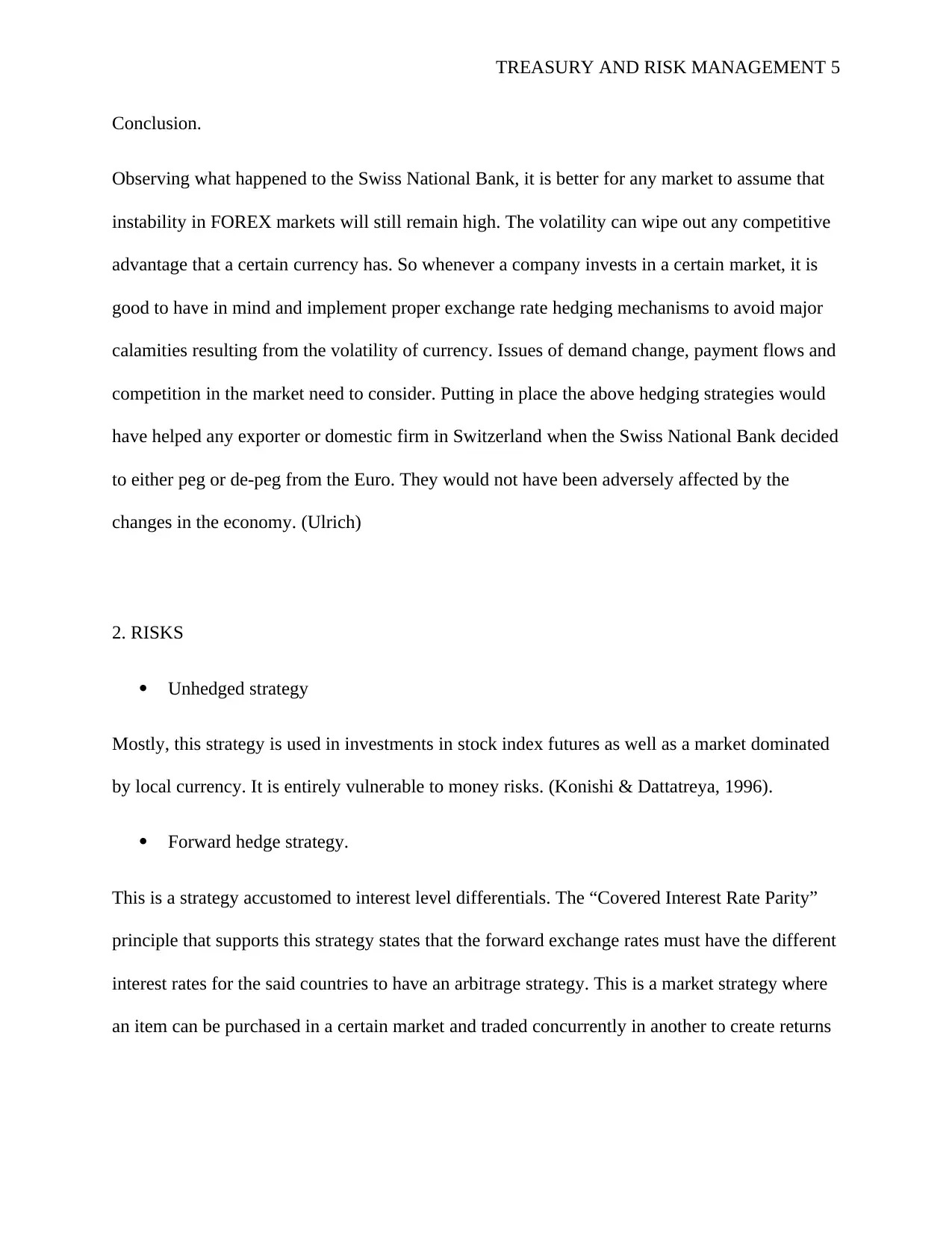
TREASURY AND RISK MANAGEMENT 5
Conclusion.
Observing what happened to the Swiss National Bank, it is better for any market to assume that
instability in FOREX markets will still remain high. The volatility can wipe out any competitive
advantage that a certain currency has. So whenever a company invests in a certain market, it is
good to have in mind and implement proper exchange rate hedging mechanisms to avoid major
calamities resulting from the volatility of currency. Issues of demand change, payment flows and
competition in the market need to consider. Putting in place the above hedging strategies would
have helped any exporter or domestic firm in Switzerland when the Swiss National Bank decided
to either peg or de-peg from the Euro. They would not have been adversely affected by the
changes in the economy. (Ulrich)
2. RISKS
Unhedged strategy
Mostly, this strategy is used in investments in stock index futures as well as a market dominated
by local currency. It is entirely vulnerable to money risks. (Konishi & Dattatreya, 1996).
Forward hedge strategy.
This is a strategy accustomed to interest level differentials. The “Covered Interest Rate Parity”
principle that supports this strategy states that the forward exchange rates must have the different
interest rates for the said countries to have an arbitrage strategy. This is a market strategy where
an item can be purchased in a certain market and traded concurrently in another to create returns
Conclusion.
Observing what happened to the Swiss National Bank, it is better for any market to assume that
instability in FOREX markets will still remain high. The volatility can wipe out any competitive
advantage that a certain currency has. So whenever a company invests in a certain market, it is
good to have in mind and implement proper exchange rate hedging mechanisms to avoid major
calamities resulting from the volatility of currency. Issues of demand change, payment flows and
competition in the market need to consider. Putting in place the above hedging strategies would
have helped any exporter or domestic firm in Switzerland when the Swiss National Bank decided
to either peg or de-peg from the Euro. They would not have been adversely affected by the
changes in the economy. (Ulrich)
2. RISKS
Unhedged strategy
Mostly, this strategy is used in investments in stock index futures as well as a market dominated
by local currency. It is entirely vulnerable to money risks. (Konishi & Dattatreya, 1996).
Forward hedge strategy.
This is a strategy accustomed to interest level differentials. The “Covered Interest Rate Parity”
principle that supports this strategy states that the forward exchange rates must have the different
interest rates for the said countries to have an arbitrage strategy. This is a market strategy where
an item can be purchased in a certain market and traded concurrently in another to create returns
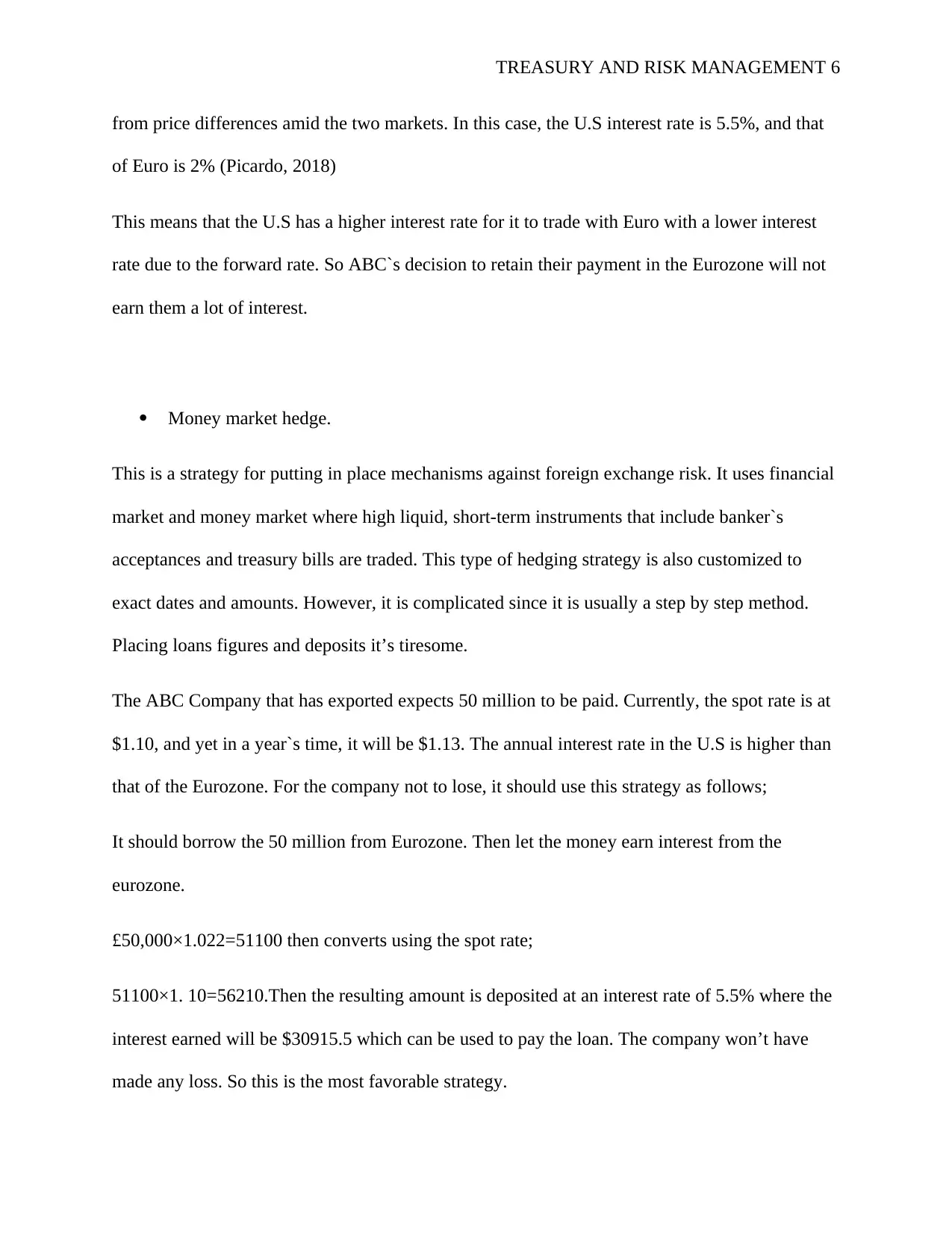
TREASURY AND RISK MANAGEMENT 6
from price differences amid the two markets. In this case, the U.S interest rate is 5.5%, and that
of Euro is 2% (Picardo, 2018)
This means that the U.S has a higher interest rate for it to trade with Euro with a lower interest
rate due to the forward rate. So ABC`s decision to retain their payment in the Eurozone will not
earn them a lot of interest.
Money market hedge.
This is a strategy for putting in place mechanisms against foreign exchange risk. It uses financial
market and money market where high liquid, short-term instruments that include banker`s
acceptances and treasury bills are traded. This type of hedging strategy is also customized to
exact dates and amounts. However, it is complicated since it is usually a step by step method.
Placing loans figures and deposits it’s tiresome.
The ABC Company that has exported expects 50 million to be paid. Currently, the spot rate is at
$1.10, and yet in a year`s time, it will be $1.13. The annual interest rate in the U.S is higher than
that of the Eurozone. For the company not to lose, it should use this strategy as follows;
It should borrow the 50 million from Eurozone. Then let the money earn interest from the
eurozone.
£50,000×1.022=51100 then converts using the spot rate;
51100×1. 10=56210.Then the resulting amount is deposited at an interest rate of 5.5% where the
interest earned will be $30915.5 which can be used to pay the loan. The company won’t have
made any loss. So this is the most favorable strategy.
from price differences amid the two markets. In this case, the U.S interest rate is 5.5%, and that
of Euro is 2% (Picardo, 2018)
This means that the U.S has a higher interest rate for it to trade with Euro with a lower interest
rate due to the forward rate. So ABC`s decision to retain their payment in the Eurozone will not
earn them a lot of interest.
Money market hedge.
This is a strategy for putting in place mechanisms against foreign exchange risk. It uses financial
market and money market where high liquid, short-term instruments that include banker`s
acceptances and treasury bills are traded. This type of hedging strategy is also customized to
exact dates and amounts. However, it is complicated since it is usually a step by step method.
Placing loans figures and deposits it’s tiresome.
The ABC Company that has exported expects 50 million to be paid. Currently, the spot rate is at
$1.10, and yet in a year`s time, it will be $1.13. The annual interest rate in the U.S is higher than
that of the Eurozone. For the company not to lose, it should use this strategy as follows;
It should borrow the 50 million from Eurozone. Then let the money earn interest from the
eurozone.
£50,000×1.022=51100 then converts using the spot rate;
51100×1. 10=56210.Then the resulting amount is deposited at an interest rate of 5.5% where the
interest earned will be $30915.5 which can be used to pay the loan. The company won’t have
made any loss. So this is the most favorable strategy.
⊘ This is a preview!⊘
Do you want full access?
Subscribe today to unlock all pages.

Trusted by 1+ million students worldwide
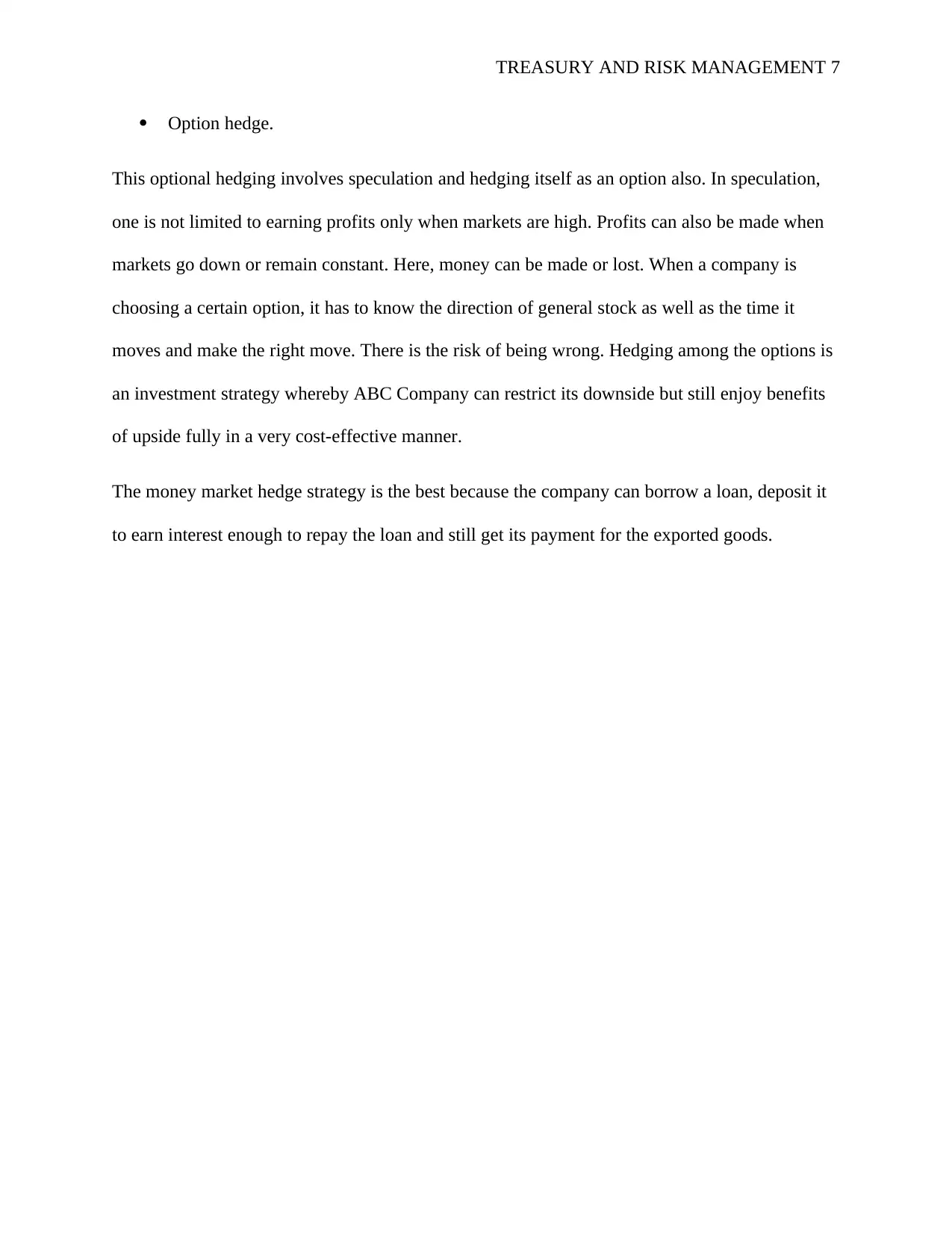
TREASURY AND RISK MANAGEMENT 7
Option hedge.
This optional hedging involves speculation and hedging itself as an option also. In speculation,
one is not limited to earning profits only when markets are high. Profits can also be made when
markets go down or remain constant. Here, money can be made or lost. When a company is
choosing a certain option, it has to know the direction of general stock as well as the time it
moves and make the right move. There is the risk of being wrong. Hedging among the options is
an investment strategy whereby ABC Company can restrict its downside but still enjoy benefits
of upside fully in a very cost-effective manner.
The money market hedge strategy is the best because the company can borrow a loan, deposit it
to earn interest enough to repay the loan and still get its payment for the exported goods.
Option hedge.
This optional hedging involves speculation and hedging itself as an option also. In speculation,
one is not limited to earning profits only when markets are high. Profits can also be made when
markets go down or remain constant. Here, money can be made or lost. When a company is
choosing a certain option, it has to know the direction of general stock as well as the time it
moves and make the right move. There is the risk of being wrong. Hedging among the options is
an investment strategy whereby ABC Company can restrict its downside but still enjoy benefits
of upside fully in a very cost-effective manner.
The money market hedge strategy is the best because the company can borrow a loan, deposit it
to earn interest enough to repay the loan and still get its payment for the exported goods.
Paraphrase This Document
Need a fresh take? Get an instant paraphrase of this document with our AI Paraphraser
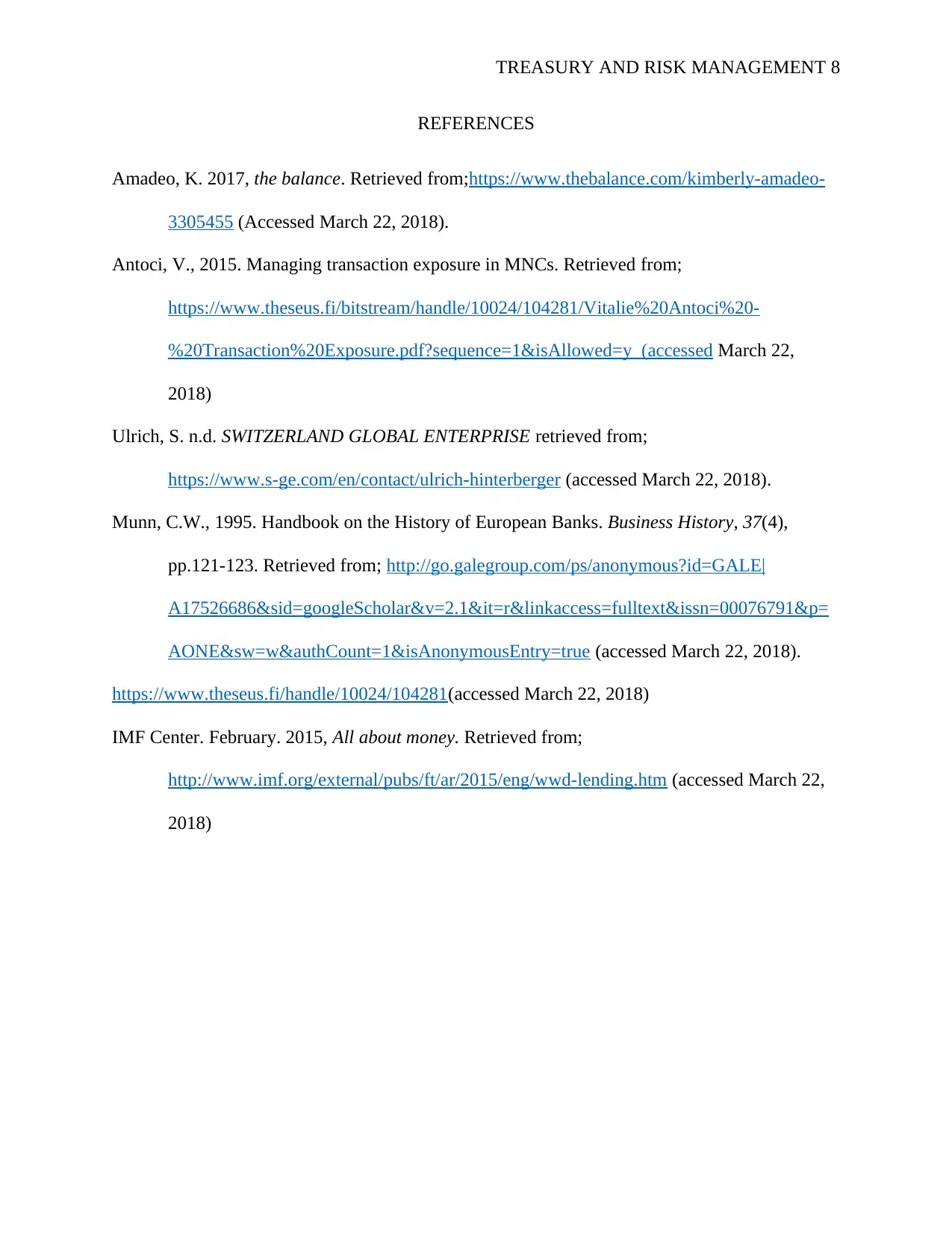
TREASURY AND RISK MANAGEMENT 8
REFERENCES
Amadeo, K. 2017, the balance. Retrieved from;https://www.thebalance.com/kimberly-amadeo-
3305455 (Accessed March 22, 2018).
Antoci, V., 2015. Managing transaction exposure in MNCs. Retrieved from;
https://www.theseus.fi/bitstream/handle/10024/104281/Vitalie%20Antoci%20-
%20Transaction%20Exposure.pdf?sequence=1&isAllowed=y (accessed March 22,
2018)
Ulrich, S. n.d. SWITZERLAND GLOBAL ENTERPRISE retrieved from;
https://www.s-ge.com/en/contact/ulrich-hinterberger (accessed March 22, 2018).
Munn, C.W., 1995. Handbook on the History of European Banks. Business History, 37(4),
pp.121-123. Retrieved from; http://go.galegroup.com/ps/anonymous?id=GALE|
A17526686&sid=googleScholar&v=2.1&it=r&linkaccess=fulltext&issn=00076791&p=
AONE&sw=w&authCount=1&isAnonymousEntry=true (accessed March 22, 2018).
https://www.theseus.fi/handle/10024/104281(accessed March 22, 2018)
IMF Center. February. 2015, All about money. Retrieved from;
http://www.imf.org/external/pubs/ft/ar/2015/eng/wwd-lending.htm (accessed March 22,
2018)
REFERENCES
Amadeo, K. 2017, the balance. Retrieved from;https://www.thebalance.com/kimberly-amadeo-
3305455 (Accessed March 22, 2018).
Antoci, V., 2015. Managing transaction exposure in MNCs. Retrieved from;
https://www.theseus.fi/bitstream/handle/10024/104281/Vitalie%20Antoci%20-
%20Transaction%20Exposure.pdf?sequence=1&isAllowed=y (accessed March 22,
2018)
Ulrich, S. n.d. SWITZERLAND GLOBAL ENTERPRISE retrieved from;
https://www.s-ge.com/en/contact/ulrich-hinterberger (accessed March 22, 2018).
Munn, C.W., 1995. Handbook on the History of European Banks. Business History, 37(4),
pp.121-123. Retrieved from; http://go.galegroup.com/ps/anonymous?id=GALE|
A17526686&sid=googleScholar&v=2.1&it=r&linkaccess=fulltext&issn=00076791&p=
AONE&sw=w&authCount=1&isAnonymousEntry=true (accessed March 22, 2018).
https://www.theseus.fi/handle/10024/104281(accessed March 22, 2018)
IMF Center. February. 2015, All about money. Retrieved from;
http://www.imf.org/external/pubs/ft/ar/2015/eng/wwd-lending.htm (accessed March 22,
2018)
1 out of 8
Related Documents
Your All-in-One AI-Powered Toolkit for Academic Success.
+13062052269
info@desklib.com
Available 24*7 on WhatsApp / Email
![[object Object]](/_next/static/media/star-bottom.7253800d.svg)
Unlock your academic potential
Copyright © 2020–2025 A2Z Services. All Rights Reserved. Developed and managed by ZUCOL.




